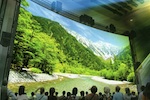BBC outlines Olympic Super Hi-Vision plans
 One of the highlights of last week’s busy BVE was a session that saw BBC R&D’s John Zubrzycki detail the plans for the Corporation and NHK’s Super Hi-Vision experiments from the London Olympics; which was equally interesting in places for what it revealed about the format.
One of the highlights of last week’s busy BVE was a session that saw BBC R&D’s John Zubrzycki detail the plans for the Corporation and NHK’s Super Hi-Vision experiments from the London Olympics; which was equally interesting in places for what it revealed about the format.
First off, it seems there are suddenly two Super Hi-Vision standards, with a 3840 x 2160, 4k version now on the slate, dubbed SHV 1, as well as the standard 8k version (which moves to being SHV 2). It looks like this has been designed to fit inside a 16:9 container within the Digital Cinema Initiative 4k specification, and could therefore serve as a useful step on the way to the full on 7680 x 4320 experience. Also a 120fps spec has been added to the general standard for 1 and 2.
Zubrzycki also highlighted the fact that the format has been designed for Japanese living rooms and, in a brave attempt to bring the IMAX experience into the domestic environment, the idea is that the viewer sits 0.75x the picture height away from the screen to ensure their peripheral vision is filled with the image. This implies a domestic set up with 100-200in screens and people sitting 1 to 2 metres away from them, which is going to involve a certain amount of shifting the furniture round in most living rooms.
“It’s not television it’s telepresence,” he commented. “As a domestic service it’s probably a bit early for us.”
Hence the three public, 50-foot screens that will be showing SHV content round the UK, which will mirror the three public screens also being established in Japan. There will also be a VIP viewing site at the Olympic IBC. Why this configuration? Because that’s what you get when you throw all the SHV kit existing in the world at a project, with a few spares left over for emergencies.
The main effort behind the project comes from the BBC, NHK and OBS, with a variety of associates, primarily high speed academic networks such as JANET (originally the Joint Academic NETwork) in the UK. The SHV signal will get back to Japan via a chain of private academic networks – one via the US and one via Asia for diversity back-up. “We did once let it out onto the raw internet and it couldn’t take it. I hope none of you were trying to download email at that point,” quipped Zubrzycki.
Two cameras will be used at the Olympic Park, and the signal will go via an NHK OB van being specially shipped in for the occasion – simple switching only, as realtime effects on 8k streams are not quiet in range yet – to Television Centre in London and the VIP showcase by dual-diversity dark fibre. From TVC it will be compressed into IP packets – 16 x 1080i signals converted into 8 x 1080p signals – and sent to the public screens as two MPEG transport streams.
The actual shows produced at the public viewing sites will be 45 minutes long and starting on the hour, every hour. Tickets in the UK at least – Zubrzycki didn’t have details for the Japanese plans – will be free via the BBC’s usual ticketing website.
Tests will be continuing during March and June, and one last interesting snippet: the recording medium was hard drive originally but has now been switched to 16x P2 recorders working in parallel.
